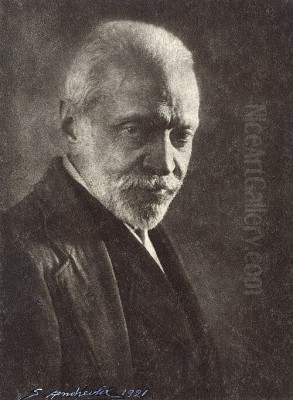
Gaetano Bellei stands as a significant figure in late 19th and early 20th-century Italian art, a period of transition and diverse artistic exploration. An accomplished painter, Bellei carved a niche for himself with his charming genre scenes, insightful portraits, and a style that beautifully blended academic precision with a palpable romantic sensibility. His works continue to be admired for their technical skill, emotional depth, and their delightful depiction of everyday life and human sentiment.
Early Life and Artistic Formation
Gaetano Bellei was born on January 22, 1857, in Modena, Italy, a city with a rich artistic heritage. His innate talent for drawing and painting became evident at a young age, leading him to pursue formal artistic training. He enrolled at the Accademia Atestina di Belle Arti in Modena (now the Istituto Superiore di Studi Musicali Orazio Vecchi - Tonelli, which also incorporated the art school), where he studied under the esteemed painter Adeodato Malatesta. Malatesta, a prominent figure in Modenese art, was known for his historical paintings and portraits, and his academic approach would have provided Bellei with a strong foundation in drawing, composition, and traditional painting techniques.
Bellei's dedication and skill did not go unnoticed. In 1881, at the age of 24, his burgeoning talent was recognized when he won the prestigious "Premio Poletti" (Poletti Prize). This scholarship was a significant achievement, providing him with the means to further his studies in Rome. The Eternal City, with its unparalleled artistic treasures from antiquity, the Renaissance, and the Baroque periods, offered an immersive learning environment. In Rome, Bellei likely attended the Accademia di San Luca, further honing his skills and absorbing the influences of both classical traditions and contemporary artistic currents. This period was crucial for his development, allowing him to refine his technique and broaden his artistic horizons.
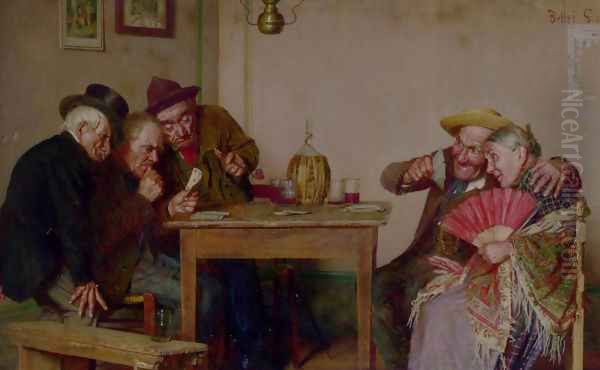
After his formative years in Rome, Bellei returned to his native region, eventually settling in Florence for a period, a city that was then a vibrant center for the arts in Italy. He became an active participant in the artistic life of the city, exhibiting his works in various local and national exhibitions. His talent and dedication eventually led to an academic appointment; Gaetano Bellei became a professor at the esteemed Accademia di Belle Arti Firenze (Florence Academy of Fine Arts), a testament to his mastery and respected position within the Italian art community. He continued to paint and teach, influencing a new generation of artists, until his death in Modena on March 20, 1922.
Artistic Style and Thematic Concerns
Gaetano Bellei's artistic output is characterized by a distinctive blend of academic rigor and a warm, romantic humanism. His training instilled in him a respect for meticulous draftsmanship, balanced composition, and a polished finish, all hallmarks of the academic tradition prevalent in 19th-century European art. However, Bellei infused this technical proficiency with a gentle sentimentality and a keen observation of human nature, aligning him with the broader currents of Realism and genre painting that gained popularity during his time.
His primary focus was on genre scenes – depictions of everyday life, often set in charming, intimately rendered domestic interiors. These scenes frequently feature elegant young women, playful children, and dignified elderly figures, each captured with a remarkable sensitivity to their character and emotional state. Bellei had a particular gift for portraying the nuances of human interaction and emotion. Whether depicting a quiet moment of contemplation, the lively engagement of a card game, or the tender bond between a grandparent and child, his paintings tell stories that resonate with universal human experiences. His figures are not mere archetypes but individuals with distinct personalities, conveyed through subtle expressions, gestures, and postures.
Portraiture was another significant aspect of Bellei's oeuvre. He approached his sitters with the same empathetic eye, seeking to capture not only a physical likeness but also an insight into their inner world. His portraits are noted for their lifelike quality and the sense of presence they convey.
Technically, Bellei was a master of his craft. His use of color was subtle yet effective, often employing a warm, harmonious palette that enhanced the intimate and inviting atmosphere of his scenes. He paid meticulous attention to detail, rendering textures – the sheen of silk, the softness of velvet, the gleam of polished wood – with remarkable fidelity. This precision, however, never led to a cold or sterile quality; instead, it served to heighten the realism and tactile appeal of his paintings. His compositions are carefully constructed, guiding the viewer's eye through the scene and highlighting the central narrative or emotional focus.
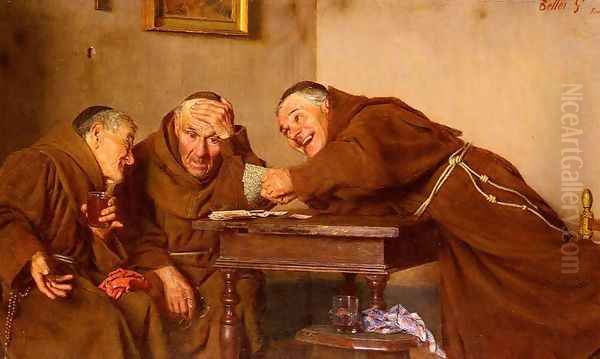
While firmly rooted in the academic tradition, Bellei's work also shows an affinity with the principles of Verismo, the Italian literary and artistic movement that emphasized a truthful and unembellished depiction of contemporary life, particularly the lives of ordinary people. His focus on everyday subjects and his ability to imbue them with dignity and emotional depth align with the spirit of this movement.
Notable Works and Their Characteristics
Gaetano Bellei's body of work includes numerous paintings that exemplify his characteristic style and thematic preoccupations. While a comprehensive catalogue is extensive, several key pieces and types of scenes stand out:
One of his most frequently reproduced and admired themes involves figures engaged in leisurely or domestic activities. Paintings like "The Card Game" (Il Gioco di Carte) are exemplary. In such works, Bellei masterfully captures the social dynamics and subtle psychological interplay between the participants. The focused expressions, the careful arrangement of hands, and the overall ambiance of the room draw the viewer into the scene. Similar themes are explored in works like "A Good Hand" and "The Winning Hand," which highlight moments of playful competition and camaraderie.
Scenes featuring elderly figures, often depicted with a sense of wisdom and gentle melancholy, are also prominent. "La Nonna" (The Grandmother) is a tender portrayal, likely showcasing the affectionate bond between generations or a quiet moment of reflection. Bellei’s ability to convey age and experience with respect and sensitivity is a hallmark of these works.
Children are frequent subjects, often portrayed with a charming innocence and vivacity. "Hide and Seek" (Nascondino) captures the playful energy of childhood, while "Three Children" might depict siblings in a moment of shared activity or quiet companionship. His painting "Le ciliegie" (The Cherries) likely features a delightful scene, perhaps children enjoying fresh fruit, a common trope in genre painting that Bellei would have executed with his characteristic charm.
Bellei also explored more allegorical or literary themes, though these are less common than his genre scenes. "Rizpah" refers to a biblical character, suggesting a foray into historical or religious subject matter, which would have been a staple of academic training. The title "The Virgin and the Four Seasons" also points to a more complex, symbolic composition.
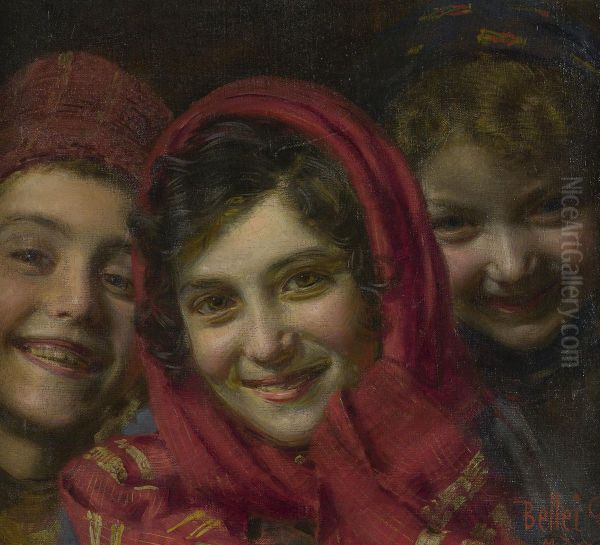
Other titles give a glimpse into the variety of his subjects: "A Good Brew" and "A Good Smoke" suggest intimate portrayals of individuals enjoying simple pleasures. "Consolation" hints at a scene of emotional support and empathy. "Five Members Of An Orchestra" indicates an interest in capturing group dynamics in a more formal setting, perhaps showcasing his skill in portraiture within a narrative context. "Off to the Masquerade" evokes the excitement and mystery of social events, allowing for a display of elaborate costumes and playful interactions. "A Windy Day" suggests an outdoor scene, perhaps a departure from his more common interior settings, showcasing his versatility.
Across these diverse subjects, Bellei’s consistent strengths are evident: his fine draftsmanship, his nuanced understanding of human emotion, his ability to create a convincing and engaging narrative, and his appealing use of color and light. His paintings often possess a gentle humor or a quiet pathos, making them accessible and relatable to a wide audience.
Bellei in the Context of His Time and Contemporaries
To fully appreciate Gaetano Bellei's contribution, it's essential to consider the artistic landscape of Italy and Europe during his active years. The late 19th century was a period of immense artistic diversity. The long-dominant Academic tradition, with its emphasis on classical ideals, historical subjects, and polished technique, was still powerful, particularly within the official art academies and Salons. Bellei himself was a product of this tradition and upheld many of its values in his meticulous approach to painting.
However, new movements were challenging the academic hegemony. In Italy, the Macchiaioli (active primarily from the 1850s to 1870s, but with lasting influence) had advocated for painting outdoors and capturing the effects of light and shadow through "macchie" (patches or spots) of color. Artists like Giovanni Fattori (1825-1908), Silvestro Lega (1826-1895), and Telemaco Signorini (1835-1901) were pioneers of this movement, focusing on scenes of contemporary Italian life and landscape with a fresh, unvarnished realism. While Bellei's style was more polished than that of the Macchiaioli, he shared their interest in depicting everyday reality.
Another important Italian movement was Verismo, which, as mentioned, found its artistic expression in the truthful depiction of contemporary life, often focusing on the lives of the common people. Artists like Francesco Paolo Michetti (1851-1929), known for his vibrant scenes of Abruzzese peasant life, and Antonio Mancini (1852-1930), with his psychologically intense portraits and genre scenes often featuring circus performers or impoverished children, embodied different facets of this trend. Bellei's sentimental realism, while perhaps less gritty than some Verismo painters, certainly partook in this broader cultural shift towards contemporary subject matter.
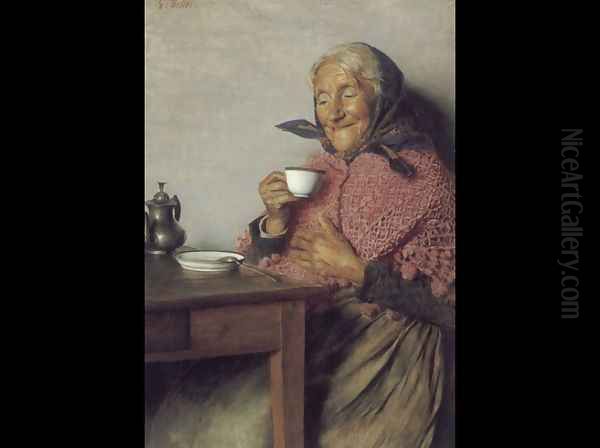
The Scapigliatura movement, centered in Milan, embraced a more bohemian and anti-academic stance, with artists like Tranquillo Cremona (1837-1878) and Daniele Ranzoni (1843-1889) known for their sfumato-like brushwork and emotionally charged, often melancholic, subjects. Bellei’s work, with its clarity and precision, stands in contrast to the more nebulous forms of the Scapigliati.
Internationally, Bellei's contemporaries included figures who also excelled in genre painting and portraiture. In France, artists like James Tissot (1836-1902) depicted elegant scenes of Victorian and Parisian society with meticulous detail. The great American expatriate John Singer Sargent (1856-1925), a year older than Bellei, was dazzling Europe with his bravura portraits. The Spanish painter Joaquín Sorolla (1863-1923) was renowned for his sun-drenched beach scenes and portraits, capturing light with extraordinary vitality.
Within Italy itself, other notable contemporaries who achieved success with society portraits and charming genre scenes include Giovanni Boldini (1842-1931), whose flamboyant, dynamic portraits captured the Belle Époque elite, and Vittorio Matteo Corcos (1859-1933), known for his elegant depictions of modern women. Giuseppe De Nittis (1846-1884), though dying relatively young, gained international fame for his sophisticated urban scenes of Paris and London. Federico Zandomeneghi (1841-1917), another Italian who spent much of his career in Paris, aligned himself with the Impressionists, capturing intimate moments of women's lives. Even the more traditional academic painter Domenico Morelli (1823-1901), a leading figure in Naples, explored romantic and historical themes with dramatic flair.
Bellei's work fits comfortably within this milieu of skilled painters who catered to a bourgeois clientele appreciative of well-crafted, relatable, and often sentimental depictions of life. He did not align himself with the radical avant-garde movements that were beginning to emerge, such as Divisionism (exemplified by Giovanni Segantini) or Futurism (which would erupt after his most productive period). Instead, he perfected a style that found a ready audience and critical appreciation for its charm and technical accomplishment.
Exhibitions, Recognition, and Anecdotes
Gaetano Bellei actively participated in the exhibition circuit of his time, which was crucial for an artist's reputation and commercial success. He regularly showed his works at important national exhibitions in Italy, including those held in Florence, Turin, and Milan. These exhibitions were major cultural events, attracting large audiences and critical attention. His success in these venues helped to solidify his reputation as a leading genre painter.
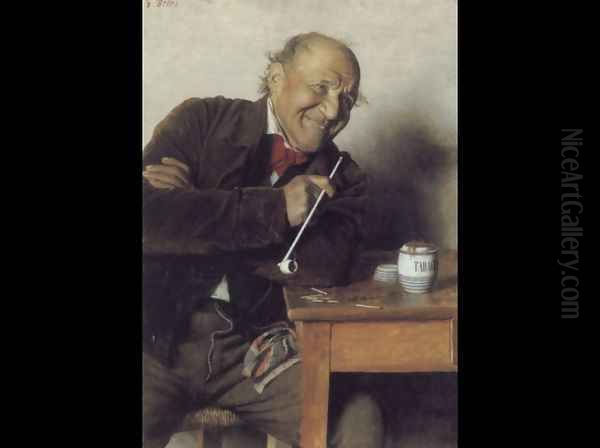
His recognition extended beyond Italian borders. The provided information notes that his works were exhibited at the Royal Academy in London, a significant achievement indicating that his art appealed to an international audience and met the standards of one of Europe's most prestigious art institutions. This international exposure would have further enhanced his standing.
While specific, detailed "anecdotes" or "unusual events" in the sensational sense are not prominently recorded in easily accessible sources for Gaetano Bellei, his life story is one of dedicated artistic pursuit and achievement. The "anecdotes" he offers us are perhaps best found within his paintings themselves – the captured moments of joy, contemplation, mischief, or tenderness that speak to the enduring human condition. His ability to win the Poletti Prize, his professorship at the Florence Academy, and his participation in international exhibitions are testaments to a career built on talent, hard work, and consistent quality.
The very nature of his art—focusing on the intimate, the everyday, and the sentimental—suggests an artist with a keen power of observation and a deep empathy for his subjects. His dedication to capturing these fleeting moments with such care and precision speaks to a profound appreciation for the beauty and emotional richness of ordinary life. The consistent demand for his work and its continued presence in art collections and auctions today is a form of ongoing recognition.
Later Life, Death, and Legacy
Gaetano Bellei continued his artistic practice and his teaching responsibilities into the early 20th century. He remained committed to his style of sentimental realism, even as more modernist art movements began to gain traction. His work provided a comforting and relatable vision of life that retained its appeal for a significant segment of the art-buying public.
He passed away in his native Modena on March 20, 1922, at the age of 65. By the time of his death, the art world was already undergoing profound transformations, with movements like Cubism, Futurism, and Surrealism challenging traditional modes of representation. In this rapidly changing artistic climate, artists like Bellei, who adhered to more traditional styles, might have been temporarily overshadowed by the avant-garde.
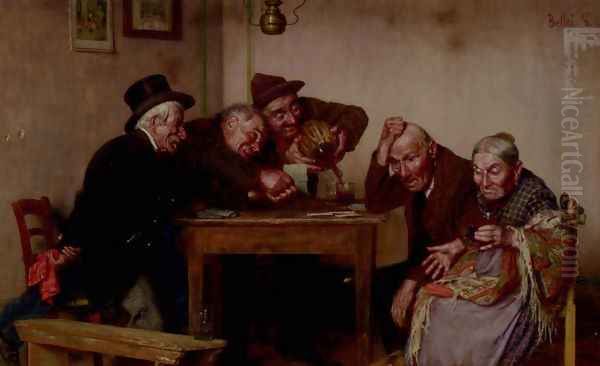
However, in subsequent decades, there has been a renewed appreciation for the technical skill and narrative charm of 19th-century academic and genre painters. Gaetano Bellei's works are now sought after by collectors and are represented in various public and private collections. His paintings are valued for their meticulous execution, their delightful subject matter, and their ability to evoke the atmosphere and sentiments of a bygone era.
His legacy lies in his contribution to Italian genre painting. He was a master at capturing the small, intimate moments of life, imbuing them with a warmth and humanity that continues to resonate with viewers. His depictions of children, families, and everyday social interactions offer a window into the values and sensibilities of late 19th and early 20th-century Italian society. As a professor, he also played a role in transmitting artistic knowledge and skills to a younger generation.
Conclusion
Gaetano Bellei was an artist of considerable talent and sensitivity, who excelled in portraying the human side of life with grace, technical skill, and heartfelt emotion. His paintings, whether depicting lively card games, tender family moments, or introspective portraits, are characterized by their meticulous detail, warm palettes, and engaging narratives. While he may not have been a revolutionary innovator in the mold of the avant-garde, he was a master of his chosen genre, creating works that brought joy and beauty to his contemporaries and continue to be admired today. His art serves as a charming and enduring testament to the everyday dramas and quiet pleasures of human existence, securing his place as a respected figure in the rich tapestry of Italian art.